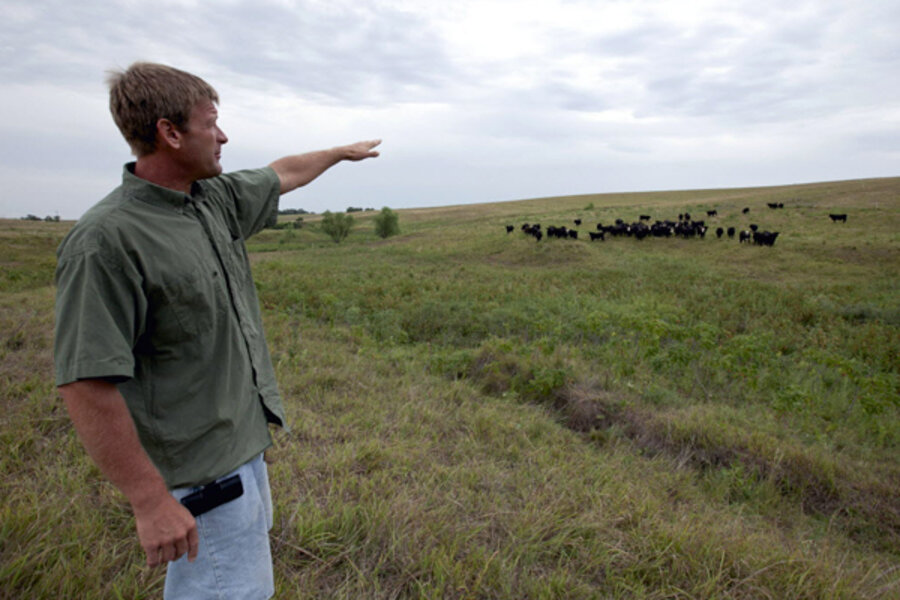Hay shortage sows distress among US livestock owners
Loading...
| Chicago
Cattle ranchers and farmers are in a frantic search for hay to feed their livestock, the consequence of a summer drought that has devastated crops and could lead to higher beef prices next year.
By the end of 2012, alfalfa hay production – the dominant form of hay due to its rich nutrients – will drop 16 percent compared with the previous year, the lowest level since 1953, the US Department of Agriculture (USDA) forecasts in a report released this month.
Total hay production will likely total 120 million tons, an 8.4 percent drop from 131 million tons last year, the USDA says.
“It’s really significant problem, what is going on right now,” says Beth Nelson, president of the National Alfalfa & Forage Alliance, an industry trade group in St. Paul, Minn. “Because you’re talking about feed for the livestock industry, it’s going to take some time and it will have more than a one-year impact.”
Hardest hit by the drought are the Midwest and Great Plains states, where the US Drought Monitor says the majority of the nation’s hay and grazing acreage is located. To date, the drought is affecting 66 percent of US hay acreage and 73 percent of area used to graze cattle. Hot temperatures and dry conditions made the drought the worst America has experienced in 56 years, according to the National Drought Mitigation Center at the University of Nebraska in Lincoln.
Earlier this month, the USDA announced nearly $30 million in financial and technical assistance to crop and livestock operators in 19 states affected by the drought. The funds can be used to help move water to livestock in drought-stricken areas and to provide emergency forage.
Last week, the USDA opened 3.8 million acres of conservation land for emergency grazing and hay harvesting. The department says 2,880 counties across the US were approved for use of the land, but some ranchers say that the cost of transporting cattle to the areas can be prohibitive, and that the protected land is not often as nutritious as the pasture grass and hay their livestock normally feed on for almost two years before slaughter.
The land receives protective status because it is prone to wind or water erosion, making it a wildlife habitat or wetlands.
There are pitfalls in redirecting farmers and cattle ranchers to the federally backed land, says Bruce Anderson, a professor of agronomy and horticulture at the University of Nebraska in Lincoln. Just because the land is released for grazing or haying “doesn’t mean it grew any better than anything else did in those areas," Mr. Anderson says.
“The quality of the kind of hay that may come from those fields is going to be very poor because it’s going to come from growth that developed a year ago or two years ago that was left standing and is now weathered and damaged by whatever conditions it experienced out there,” Anderson says. “So the nutrients declined and it’s now a less valuable feed resource than when it was green or growing and fresh.”
Other options available to cattle ranchers and farmers are feeding their livestock weathered cornstalks, a less nutritional form of feed, and searching online resources to buy hay from other parts of the country.
Even that search process is fraught with difficulties, as most sellers are selling hay at almost three times the price from last year, will deal only in cash, and are rationing their supply, which means that farmers with a large stock of animals to feed are being forced to buy intermittingly and not in bulk.
“It’s hard to find. The quality is pretty decent but there’s just not any to be had,” says Steve Fridley, a racehorse trainer in Alhambra, Ill., who owns or trains about 40 horses. Last year, Mr. Fridley says, he paid $55 for a large square hay barrel; this year, the price is $135. What’s worse is the prolonged effort to acquire hay. In the past, he bought directly from his neighbor down the road, but since that crop dried up, he is forced to search online and pay hefty transportation costs.
The feed shortage, he says, will likely force him to sell at least 10 horses at rock-bottom prices.
“You can’t hardly give them away. They’re hard to get rid of because everybody is saying, ‘How do I feed it?' ” Fridley says. As for the horses he trains that are owned by others, he says he’ll likely be forced to raise his prices, which he expects will hurt his business long past this summer.
“You can’t do something and lose money doing it for very long,” he says.
The drought is the primary reason the USDA is forecasting a drop in total red meat and poultry production in 2013 – from 93 billion pounds expected this year to 91 billion next year, a 2 percent drop. The retrenchment is expected to inflate meat prices next year, especially for beef because smaller herds will yield fewer calves, which can take up to 18 months to reach slaughtering weight.
Before then, ranchers are busy culling their herds and sending them to slaughter before they would otherwise be ready to avoid further investment in feed cost.
Prices are already higher than they were a year ago. For the week of Aug. 17, wholesale boxed beef prices were $7.50/Cwt (or 100 pounds), compared with $3.30 for the same week last year, according to the USDA.
Hay producers do not typically have insurance because it provides less coverage than does insurance for most soil crops like corn and soybeans, Ms. Nelson says. Because hay is not traded on the national exchanges, hay producers have little option but to wait until next year.
“They really don’t have any other options right now,” she says.







